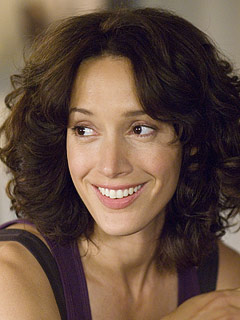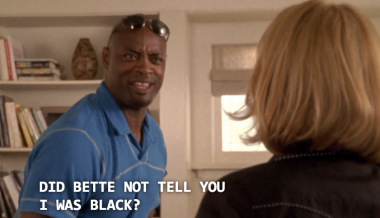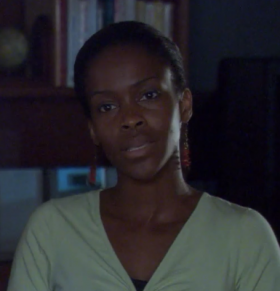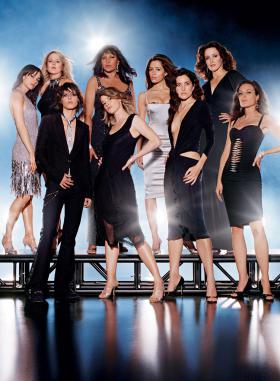December 13, 2014 - 21:04

“A Cast of Beautiful People”:
Bette’s Failed Empathy and Intersectional Representation in The L Word
Sula Malina
December 13th, 2014
“The point of intersectional analysis is not to find ‘several identities under one’…This would reinscribe the fragmented, additive model of oppression and essentialize specific social identities. Instead the point is to analyse the differential ways by which social divisions are concretely enmeshed and constructed by each other and how they relate to political and subjective constructions of identities”
- Yuval-Davis, cited by Erevelles and Minear (131)
The L Word: The First of Its Kind
The L Word, a show focusing on the lives of a group of queer women in Los Angeles, made its appearance on Showtime between 2004 and 2009, and appears to be a perfect example of what Yuval-Davis warns against. In the span of six seasons, the creator, Ilene Chaiken, attempted to shift the nation’s notion of what it meant to be homosexual, and to normalize the “deviant” identity through relatable storylines and sometimes shockingly explicit sex scenes—but, in doing so, presented a group of women included solely due to their similar sexual identities. Prominent theorists such as Eve Sedgwick applauded the series, describing The L Word as a “visible world in which lesbians exist, go on existing, exist in forms beyond the solitary and the couple, sustain and develop relations among themselves of difference and commonality” (Wolfe & Roripaugh 43). At last, as Jennifer Beals (the actor who once played Bette Porter) explained, there was a series intended “to represent people who don’t often see themselves represented, and certainly not represented in multiplicity” (Heller 55).
Although Chaiken portrayed lesbians who were almost entirely femmes (save for the androgynous heartthrob, Shane), she and her team made a number of attempts at alternative identity representation, including gender, class, and race. In fact, The L Word has received praise from reviewers for its supposedly diverse representation of other identities, including from minority races to disabilities (Heller 56) Still, at times, inclusion of these variant bodies were presented as jokes—such as the character of Lisa, a lesbian-identified man meant to drive the bisexual Alice back into her “rightful state” of lesbianism. At best, inclusion of variant identities were tokenized, portrayed by a single character and granted fairly ridiculous storylines in comparison to the primary cast.
In fact, it would appear that the only vaguely multi-dimensional, intersectional main character is Bette Porter. Bette is a very proud and vocal lesbian, as well as a biracial (often white-passing), upper-class, able-bodied individual. She is powerful in the art world, and is the Director of the California Arts Center, a prominent and subversive part of the Los Angeles art scene. Clearly, even with her racial identity, Bette is a very privileged woman. Her many identities come into play early on in the first season, when she and her partner, Tina, decide they would like to have a baby. As Tina plans to carry the child, Bette pushes for an African-American sperm donor, so the baby can look like both of them. This sparks debate around both Bette and Tina’s identities.
Arguably because of her intersectional identities, Bette is presented as one of the more empathetic characters (despite her sometimes abrasive personality). As tokenized characters come into the show, Bette is the first to show them respect and attempts to communicate with them on their own level—and given her place on the board of the CAC, she is frequently presented as the most politically correct and socially aware of the main characters. Yet this martyr status comes into question in a number of interactions throughout the series.
Bette’s method of coping in these interactions, along with her failure to communicate in a variety of contact zones signals a major failure on the part of The L Word to value intersectional, non-normative identities, as even the most multi-dimensional, empathetic character simply cannot interact appropriately with others.
Bette Porter

Identities & Intersections
Bette’s presence on the show is complicated, to say the least. Her identity is constantly in question, and she experiences the world as a bi-racial (half White and half African-American) woman who is White-passing. Her half-sister, Kit, who is also a constant presence on The L Word, is her straighter, darker counterpart. Bette frequently acts as a mentor to Kit, who has dealt with alcoholism for many years after a brief career as a singer. While Kit interacts frequently with an African-American community, dating a number of Black men over the course of the show, Bette almost never does, and surrounds herself primarily with those who fit smoothly into her social circle as a upper-class art theorist and museum director. Although Bette is the only character of color in the main cast of L Word characters, her power comes from her professional status and assertive nature, rather than from her race. In fact, her race is frequently brushed aside or conveniently ignored, depending on the relationship in which Bette engages.
It certainly appears that a large part of why Bette is able to be so vocal about her sexual identity (and her life with her White partner, Tina Kennard) is because she is White-passing, and because she is wealthy. She has not experienced having to hide her identity, even in front of her father, who refuses to recognize “Ms. Kennard” as anything more than a friend to Bette. Still, Bette’s minority status is occasionally played up, in order to encourage compassion on the part of the viewer. Bette is seen as the “most marginalized” at the beginning of the series because of her identities, and numerous plotlines attempt to name her as empathetic as a result. Unlike characters like Tina who have seemingly never faced oppression, Bette is meant to be able to relate to minority characters who enter the show.
Horizontal & Vertical Identities
One of the primary struggles faced by Bette and her partner at the beginning of the series is the decision around having a child. Because the couple is privileged enough to afford conception through artificial insemination, Bette and Tina begin to struggle with what “reproduction” really means to them as lesbians, who cannot biologically procreate between the two of them. When Bette springs the idea of an African-American sperm donor on Tina without consulting her, she demonstrates her belief in the significance of vertical identity (with a twist). Bette (and eventually Tina) values the notion that a child should look like his/her parents, and should be representative of where they come from. While Andrew Solomon, author of Far From the Tree might label this application of race as a vertical identity, it is not truly “passed down” from both parents, and is therefore something of an engineered vertical identity.

As Dirkson Bauman argues in his piece “Designing Deaf Babies and the Question of Disability,” there may be, in fact, some significant work being done by families who intentionally create children typically seen as “disadvantaged” in the eyes of normative society. As he writes, “Why did the reproductive choice of a single couple ignite such fury? Perhaps because it is an assault on standards of normalcy, turning them on their head, fashioning some new mutant strain of normalcy” (Bauman 311). By naming a marginalized identity as a desired one, what is defined as “normal” automatically shifts. This is particularly the case for parents who themselves identify with this marginality—because when deaf parents intentionally give birth to a deaf child, they are refusing the contact zonethat would occur between a deaf parent and a CODA (child of a deaf adult). By insisting upon an African-American donor, Bette sends the message that she would like to avoid the contact zone created by parenting a White child—she would rather relate to the child racially. In contrast to the contact zone, this phenomenon would be described by Mary Louise Pratt (author of “Arts of the Contact Zone”) as a variation on a “safe house,” a “social and intellectual space where groups can constitute themselves as horizontal, homogenous, sovereign communities with high degrees of trust, shared understandings, temporary protection from legacies of oppression” (Pratt 40). When Tina questions her own ability to parent a mixed-race baby as a White mother, she is voicing her own concerns about the contact zone that would occur for her—she would not understand the coming-of-age experience of a child of color the way she would a White one. However, is it unjust to value the “safe house” of one parent over another? It would seem that it is more appropriate in the case of Bette, who (for reasons related to her marginalized race) would face more need for a safe house with her child of color than Tina would with a White child (for the same reason that we do not generally accept White affinity groups as legitimate or appropriate).
However, it remains important to question Bette’s ability, as someone who (as White-passing, though of Black heritage) has not had the same racial experience as someone with darker skin (such as her sister, Kit). If Bette and Tina were to have a dark-skinned child, would there not still be a contact zone between Bette and her baby?
Race Representation
Although The L World has been applauded since its conception for its representation of lesbians who defy stereotypes (such as the ugly, asexual lesbian, or the lumberjack), it has frequently faced issues related to racial representation (Wolfe & Roripaugh 207). With Bette as the only main character of color, much of the responsibility for the representation of minority races is placed on tokenized characters such as Carmen, a Latina DJ who has a torrid love affair with Shane before she is left at the altar (due to Shane’s macho inability to commit). In her piece entitled “The Other ‘L’ Word: Representing a Latina Identity,” Shauna Swartz discusses the failures of the series to take Carmen’s race seriously (starting with the casting of a non-Latina actress to play the part). As she writes, “Carmen’s ethnicity is relegated to a fashion statement, tacked onto her like a costume” (Swartz 179). Just as Bette’s race seems to only come up when convenient, Carmen’s Latina identity is mentioned only for flashy appeal—to make her seem more sexy, and to add “flavor,” tastelessly, to several episodes. This is even the case for the character of Jenny, who is Jewish, and who copes with the historic struggle of her people through dream sequences and what appear to be psychedelic writing sessions. Swartz notes that The L Word has a tendency to alter the theme song to whatever identity is being represented most in a given episode—from a klezmerized version for Jenny, to a Spanish dance version for Carmen.
Swartz also comments on the tasteless manner by which the inclusion of (and focus on) Jenny’s culture-related pain reduces Carmen and Bette’s races. She writes, “It isn’t a matter of simply being unrealistic if it manages to highlight the historical oppression of Jews even as it denies the persistence of insidious racism” (Swartz 180). Essentially, even though Bette and Carmen are meant to diversify the show by their mere inclusion, the lack of focus on their day-to-day struggles with racist interactions is ultimately offensive and dismissive.
Bette’s (Failed) Empathy
Throughout the series, Bette and her friends meet a number of characters quite different than themselves, meant to add “diversity” to the program. Of course, the singularity of these characters results in their tokenization, and quite often it is these characters whom are given the more ridiculous storylines, engaging in relationships and adventures intended to shock and disgust viewers. For each of these characters, Bette acts (at one point or another) as a hero. As an empathetic, intersectional character, she can (of course) understand their plight regardless of the details.
Max Sweeney

The first of these characters is Max Sweeney, played by Daniela Sea—and of the tokenized characters, perhaps Chaiken’s only semi-successful attempt at a non-normative, intersectional one. Max enters the series as Moira, Jenny Schecter’s girlfriend, presenting as a very masculine-of-center lesbian, and wearing clothes that mark her clearly as working-class (especially in comparison to the often extravagant fashion choices of the main cast). From the moment Moira first meets Jenny’s friends (in the episode “Lobsters,” Season 3, Episode 3), there is a palpable divide between identities. They attend an extraordinarily expensive restaurant, and arrive done up with make-up and tight, sexy clothing—while Moira enters wearing a t-shirt, jeans, and a flannel button-up with the sleeves torn off. Her tokenization is presented immediately simply because of how intentionally she is made to stand out. Bette is the first and only of the main cast to actually reach out and great Moira, in an attempt to welcome her into the group. Here, she engages willingly in a contact zone—despite the obvious, visible difference in their identities, Bette is inclined to speak with Moira and to learn more about her. Yet, after several minutes of uncomfortable conversation, and forced into a position to pay for pricey, upscale food, Moira panics and leaves the restaurant, convinced she can never fit in.
Both Bette’s attempt and failure at empathy are present in this single scene; although she is the first and only of the friends to reach out and greet Moira, she later wrongly attempts to use her own position as a minority to explain away Moira’s seemingly hyper-masculine presentation. As Bette asserts: “She comes from a place where, you know, you have to define yourself as either or. It’s probably just the only language that she has to describe herself.” Although the explanation is presented as a thoughtful comment, meant to support Moira, it is really quite dividing and dismissive of Moira’s self-identification. The group fails to ever understand Moira’s gender identity—until she comes out as transgender, changes her name to Max, and begins to transition. Although Bette and her friends continue to refer to Max as “she” and “a lady” (even when Max has a full beard and is quite passably male), they are clearly more comfortable with Max when he begins to fit into a box they can identify—female masculinity is simply too complicated. As the show continues, Bette’s relationship with Max falls away to the point where it is essentially non-existent, and he remains understood only by the children who appear on the show (too young to understand his trans identity, and who easily accept him as a father figure).
Jodi Lerner

Jodi Lerner, played by Marlee Matlin, is the only representation throughout the series of a disabled character—visibly or otherwise. Played by a deaf actor, Jodi is a sculptor, an activist, and a lecturer at California University School of the Arts (where Bette becomes a dean during season 4). As Bette and Jodi find that they are attracted to one another, Bette goes out of her way to learn basic sign language, in spite of Jodi’s excellent skills at lip reading. Her effort is certainly intended to elicit an “awww” reaction from the viewer, who is witnessing someone actually willing to make the effort to love a disabled person. Chaiken portrays the relationship as out-of-the-ordinary, and entirely a result of Bette’s unique, empathetic, understanding nature.
However, while the intersectionality of Jodi’s lesbian identity and her deafness do not immediately cause a rift between the lovers, their relationship is challenged not much later (Season 4, Episode 7, “Lesson Number One”). While sitting with a co-worker and discussing life and love, Bette comes to learn that Jodi is polyamorous. She is visibly disturbed by this discovery and pouts, while others look to her sympathetically. She feels she has been wronged by Jodi, who Bette feels has kept this identity a secret in order to lead Bette on. Bette becomes a victim, destroyed by the lack of communication between herself and the deaf Jodi.
It is not long after this incident that Bette’s true colors show: at a dinner party she organizes so that Jodi can meet her friends (Season 4, Episode 10, “Little Boy Blue”). At the beginning of the evening, while the pair are hanging lights and preparing, Jodi senses that Bette is acting in a notably controlling manner, and asks her to refrain from interpreting for her. As Jodi explains, “I’m going to miss things. That’s what happens when I’m around hearing people.” However, Bette refuses to heed her girlfriend’s advice, and proceeds to pick and choose what she would like Jodi to get out of the dinner conversation. When an argument erupts between the pair after dinner and Bette defends her actions, explaining that Jodi needed her, Jodi speaks up: “You can’t handle it,” she explains. When Bette asks for clarification, Jodi responds: “That communication is different with me. That it isn’t exactly how you want it to be.” Here, Jodi gently implies that Bette is subconsciously ableist; Bette is dissatisfied with their relationship because she cannot control what information Jodi does or does not receive. She cannot handle the contact zone between the two of them, and, as Jodi explains, Bette wants someone who will work "for her, not with her.” When Jodi pushes Bette more directly on the subject of ableism, Bette bursts: “Oh, Jesus. I had no idea you felt so fucking persecuted. It makes me feel really sad for you. I think, though, for one minute, you should just ask yourself, what am I experiencing? What is my fucking experience?” Here, Bette is quite clearly out of line. However, after a brief separation, Jodi comes back to her, and the relationship continues, as if to forgive Bette of her misstep. Once again, Bette is absolved of her failed empathy, and remains a righteous (if still slightly abrasive) character in the minds of viewers.
Bette and Yolanda

Though her relationship with Yolanda occurs several seasons before she meets either Max or Jodi, Bette’s failure (and, in turn, The L Word’s failure) to grasp matters of intersectionality comes into play most directly when the two meet in group therapy. In the episode “Listen Up,” (Season 1, Episode 8), Bette and Tina agree to attend a few sessions of group therapy recommended to them by their couple’s therapist, Dan Foxworthy. However, this proves less easy for Bette; while Tina struggles at first to speak for herself, Bette refuses almost entirely to voice her insecurities around becoming a parent.
The character of Yolanda is presented toward the beginning of this encounter with a brief monologue about her greatest fear—as she states, she is most afraid “that [her] daughter will feel angry with [her] for not giving her a father.” Already, we are made to question Yolanda’s sexual identity. Though she could easily be a single, heterosexual mother, the focus of the series leads the audience to question whether she might be a lesbian, unable to provide a father figure to her child because she could only ever choose to be with a woman. Because Yolanda attends the group therapy without a partner, her identity is not immediately questioned by the other attendees. However, Yolanda is very vocal about her racial identity. An author of subversive poetry and non-fiction, Yolanda is quick to claim her Black heritage, and firmly believes that it has informed how she moves through the world.
When Bette and Tina begin to discuss with the group their dilemma around choosing an African-American donor, Yolanda jumps on them, and specifically targets Bette. She insists: “You talk so proud and forthright about being a lesbian, but you never once referred to yourself as an African-American woman. All I hear you saying is that White people should only take care of White babies.” When Bette rebuts with the argument that even the child of a lesbian couple should be able to look like his/her parents, Yolanda insists: “Before you can reflect who you are, you have to be who you are [. . .] I think before you have a child, you need to reflect on what it is you’re saying to the world by hiding so behind the lightness of your skin [. . .] I get the impression that you don’t even think of yourself as African-American!” In response, Bette claims her own ability to self-identify, by asserting: “I am, half African-American, and my mother is White.”
Here, the conversation reaches a standstill. Although forced to leave the space due to time limitations, Bette does not come to any understanding of the privilege that comes with her ability to pass as White, even if she does self-identify as bi-racial. Instead, after completing a week’s worth of research on Yolanda, she returns to the group and viciously outs her competitor: “What I wanna know is how you can justify pushing me so hard to come out as a Black woman, when all the while, you’ve let us mistake you for a straight woman.” Immediately, the camera cuts to shots of the White, straight members of the group turning and looking at each other, shocked. When Yolanda continues to shout, only to be shut down by Foxworthy for her “confrontational” attitude, the conversation ends and Bette is presented as righteous and victorious.
While Bette’s character is presented as one who is practiced in self-examination and expects the same as others, her self-analysis has certainly fallen flat. Here, Bette enters a contact zone with a proud, visibly Black woman, who encourages Bette to look at how she fails to internalize her own racial identity. Theorist Dana Heller argues that, “in these instances, Bette struggles against interpretations of her identity imposed from the outside and insists on being understood, in her own terms” (Heller 62). Though Bette does push against Yolanda’s assumptions of someone she has only just met, she ultimately fails to use this contact zone to her advantage. Rather than recognizing the privilege she has (as upper-class and White-passing) to be vocal about her sexual orientation, she essentially ignores this and instead outs Yolanda without considering why she might not have identified herself as a lesbian to the group.
Furthermore, Bette exhibits racist behaviors when she cites her source for this discovery (which happens to be a book written by Yolanda herself). Bette mocks both the title and Yolanda’s embracing of her Black identity: “In her book, Sistah, Stand Up!—with an ‘h,’ I might add…” When Yolanda continues to fight back and is told to quiet down, she quickly retorts: “Is this Black lady getting out of control? Is that what you’re trying to say, Dan? Why is it that whenever a Black woman has an opinion, she’s being confrontational?” The scene ends in uncomfortable silence, as the other attendees glance at each other, unaware of how to deal with Yolanda’s Black threat. Bette’s passing privilege remains ignored, and Yolanda’s identity is mocked both by Bette’s comment and by the episode’s director, who closes the storyline in such a dismissive way. The matter is brushed aside when Tina chooses to end the conversation by stating, “I think the best thing is to just say how we feel.” Her generalizing, dismissive statement devalues the arguments of both Yolanda and Bette, reducing their sentiments to over-the-top feelings of two Black women (even when Bette does not self-identify so simply).
The L Word: Worth It, Or Not?
The L Word has failed in many ways in its attempts to model intersectionality through representation of a group of lesbians and all of the “diversity” under that category. But does this negate the positive representation the show has provided of a non-normative sexual identity?
In response to complaints about the failings of the show, various reviewers have suggested that the lesbian community might be asking too much. As Stacey D’Erasmo expressed, “A peculiar consequence of so rarely seeing your kind on television, in movies, in plays, what have you, is that [. . .] it can feel a little limiting to be decanted into a group of perfectly nice women leading pleasant, more or less realistic lives. You can think, ungratefully: Is that all there is?” (Wolfe & Roripaugh 54). D’Erasmo seems to share the view of Samuel Chambers, author of “Heteronormativity and The L Word,” who asserts: “The L Word’s significance lies in its very existence” (Chambers 81). Both authors seem to claim that The L Word does its job simply by offering a prime time spot solely to a single, previously underrepresented identity group. Additionally, as Chambers argues, tokenizing may be simply unavoidable in shows centering around a single friend group—and in particular, one like The L Word cast (upper-class and in L.A)—as one could never realistically find ideal diversity in such a friend group (Chambers 83).
Still, one cannot help but wonder: Does the representation of a specific group necessitate the tokenization of another? If this is the case, it would seem to destroy any possibility for intersectionality at all in the media—because, for characters like Bette, only her lesbian identity can be a true constant throughout the series, while her race makes the occasional “guest appearance.” As Chambers later expresses, in admitting defeat:
“In the end, we emerge with no clear winners or losers in the representation game – both sides admit that in the case of The L Word, we have a cast of ‘Beautiful People’” (Chambers 83).
Certainly, both the main cast and the tokenized side characters are brought on to be beautiful—even the initially “trashy” Max eventually gets a high-paying job and begins to dress up just as his new “friends” do. In some ways this is a progressive representation of the lesbian community, in that it does defy the “ugly” stereotypes. But as Yuval-Davis points out, the very notion of a show devoted to a single identity (and the various identities underneath it) can be no more than a first step, as it is a destructive method of presenting intersectionality. While The L Word successfully brought lesbians into the public eye as more than lumberjacks, true representation will not arrive for any of the aforementioned identities until the norm in media is no longer White, no longer able-bodied, and no longer heterosexual. When television and film can represent a realistic diversity, so that no disabled or queer character must be the only one of his or her kind on a program, the media’s exploration of intersectionality can truly begin.

Works Cited
Bauman, H-Dirkson L. "Designing Deaf Babies and the Question of Disability." Journal of Deaf Studies and Deaf Education 10.3 (2005): 311-15. Print.
Chaiken, Ilene. “Lobsters.” The L Word. Prod. Ilene Chaiken. Dir. Bronwen Hughes. Showtime. Vancouver, BC, 22 Jan. 2006. Television.
Chambers, Samuel A. "Heteronormativity and The L Word: From a Politics of Representation to a Politics of Norms." Reading The L Word: Outing Contemporary Television. Ed. Kim Akass and Janet McCabe. N.p.: I.B.Tauris, 2006. 81-98. Print.
Erevelles, Nirmala, and Andrea Minear. "Unspeakable Offenses: Untangling Race and Disability in Discourses of Intersectionality." Journal of Literary & Cultural Disability Studies 4.2 (2010): 127-45. Print.
Heller, Dana. "How Does a Lesbian Look? Stendhal's Syndrome and The L Word." Reading The L Word: Outing Contemporary Television. Ed. Kim Akass and Janet McCabe. N.p.: I.B.Tauris, 2006. 55-68. Print.
Pratt, Mary Louise. "Arts of the Contact Zone." Profession (1991): 33-40. Print.
Roripaugh, Lee Ann. "The (In)visible Lesbian: Anxieties of Representation in The L Word." Reading The L Word: Outing Contemporary Television. By Susan J. Wolfe. Ed. Kim Akass and Janet McCabe. N.p.: I.B.Tauris, 2006. 43-54. Print.
Solomon, Andrew. "Son." Far From the Tree: Parents, Children, and the Search for Identity. N.p.: Simon and Schuster, 2012. 1-48. Print.
Swartz, Shauna. "The Other 'L' Word: Representing a Latina Identity." Reading The L Word: Outing Contemporary Television. Ed. Kim Akass and Janet McCabe. N.p.: I.B.Tauris, 2006. 177-82. Print.
Zakarin, Mark. “Listen Up.” The L Word. Prod. Ilene Chaiken. Dir. Kari Skogland. Showtime. Vancouver, BC, 7 Mar. 2004. Television.
Ziff, Elizabeth. “Little Boy Blue.” The L Word. Prod. Ilene Chaiken. Dir. Karyn Kusama. Showtime. Vancouver, BC, 11 Mar. 2007. Television.
